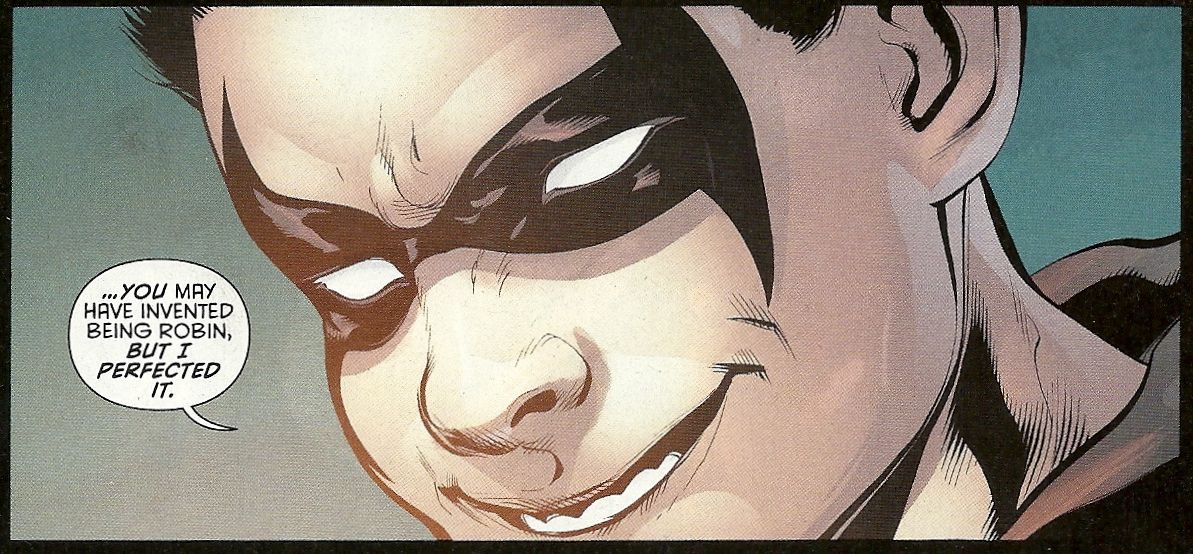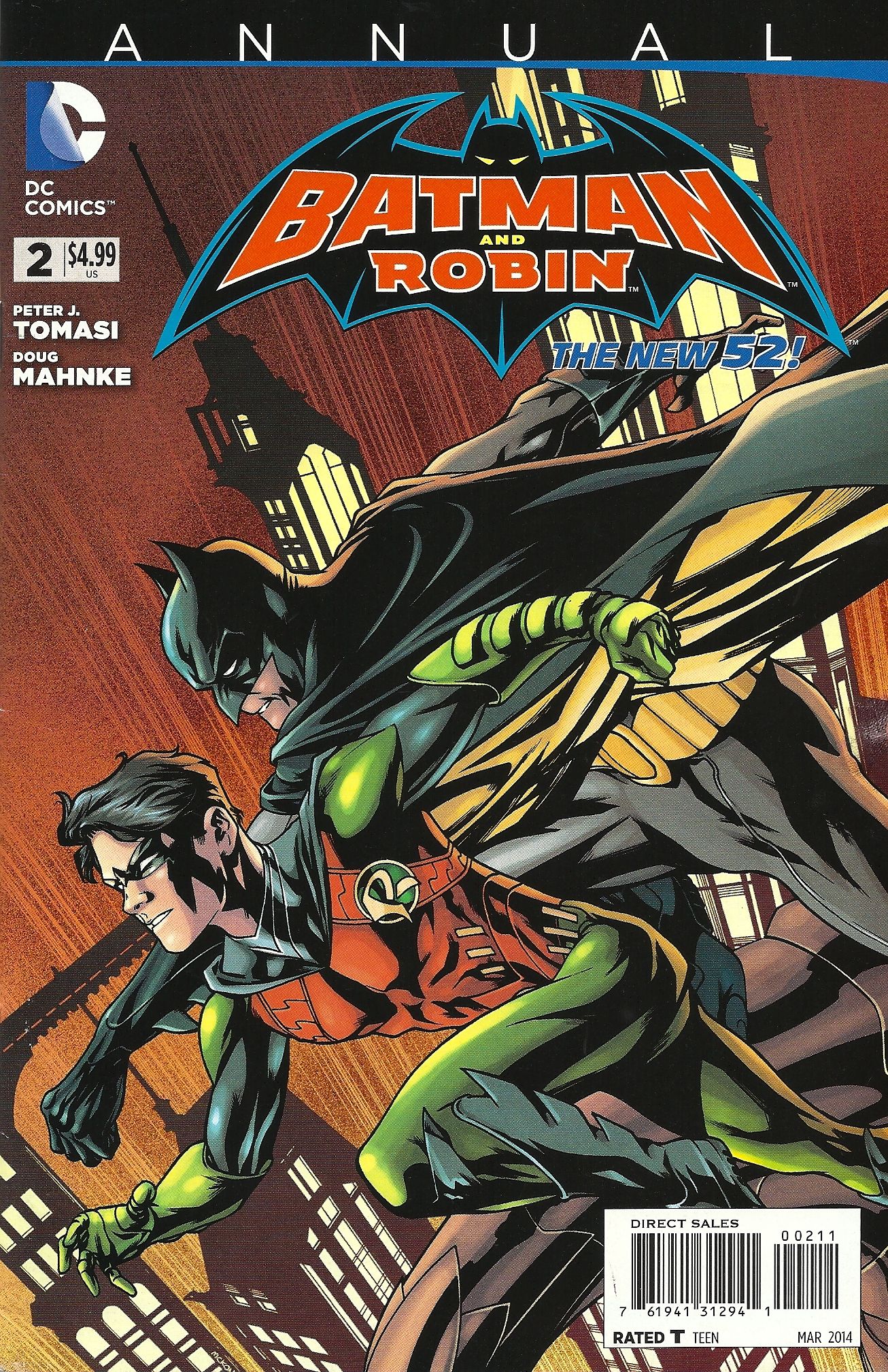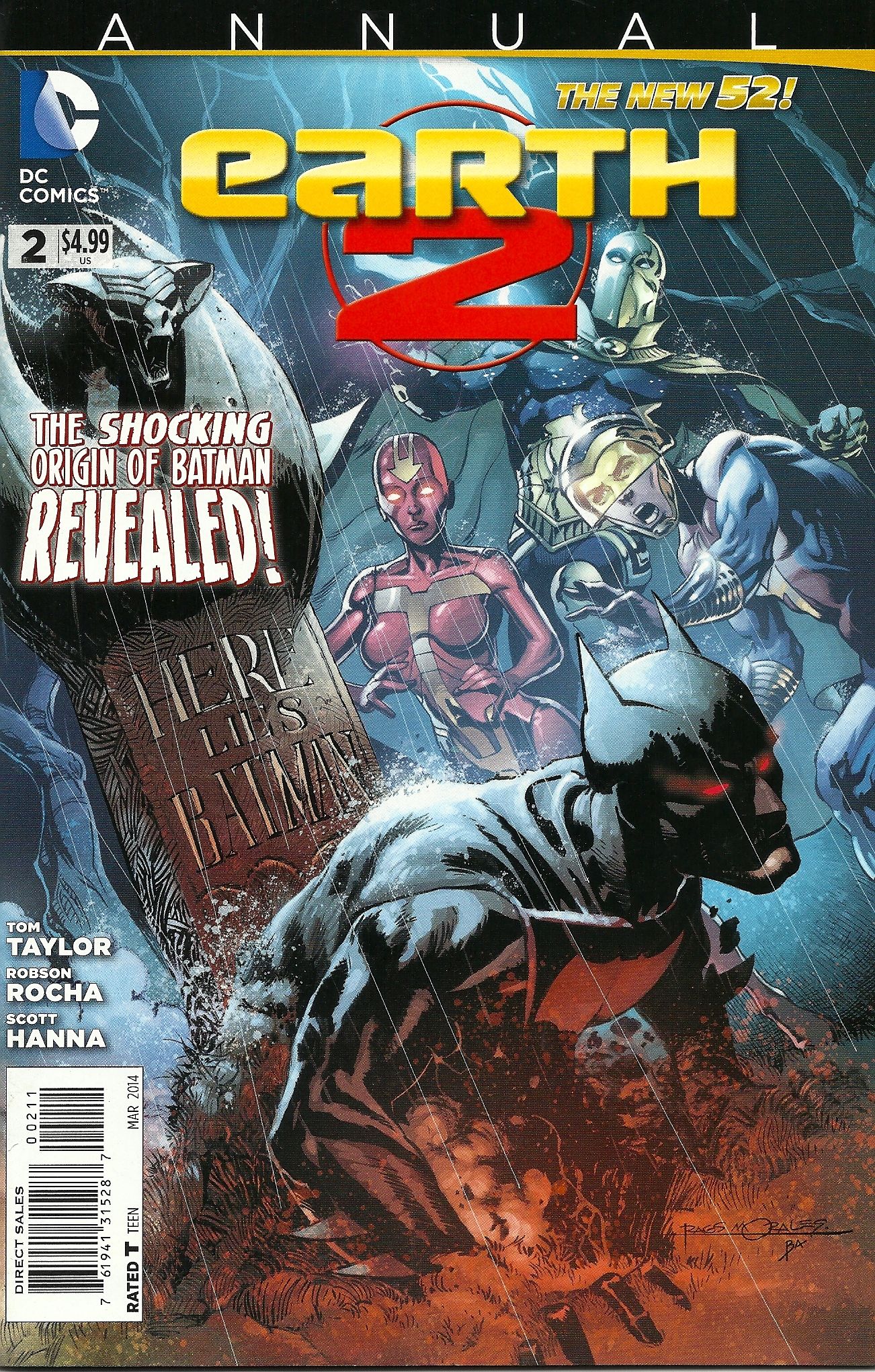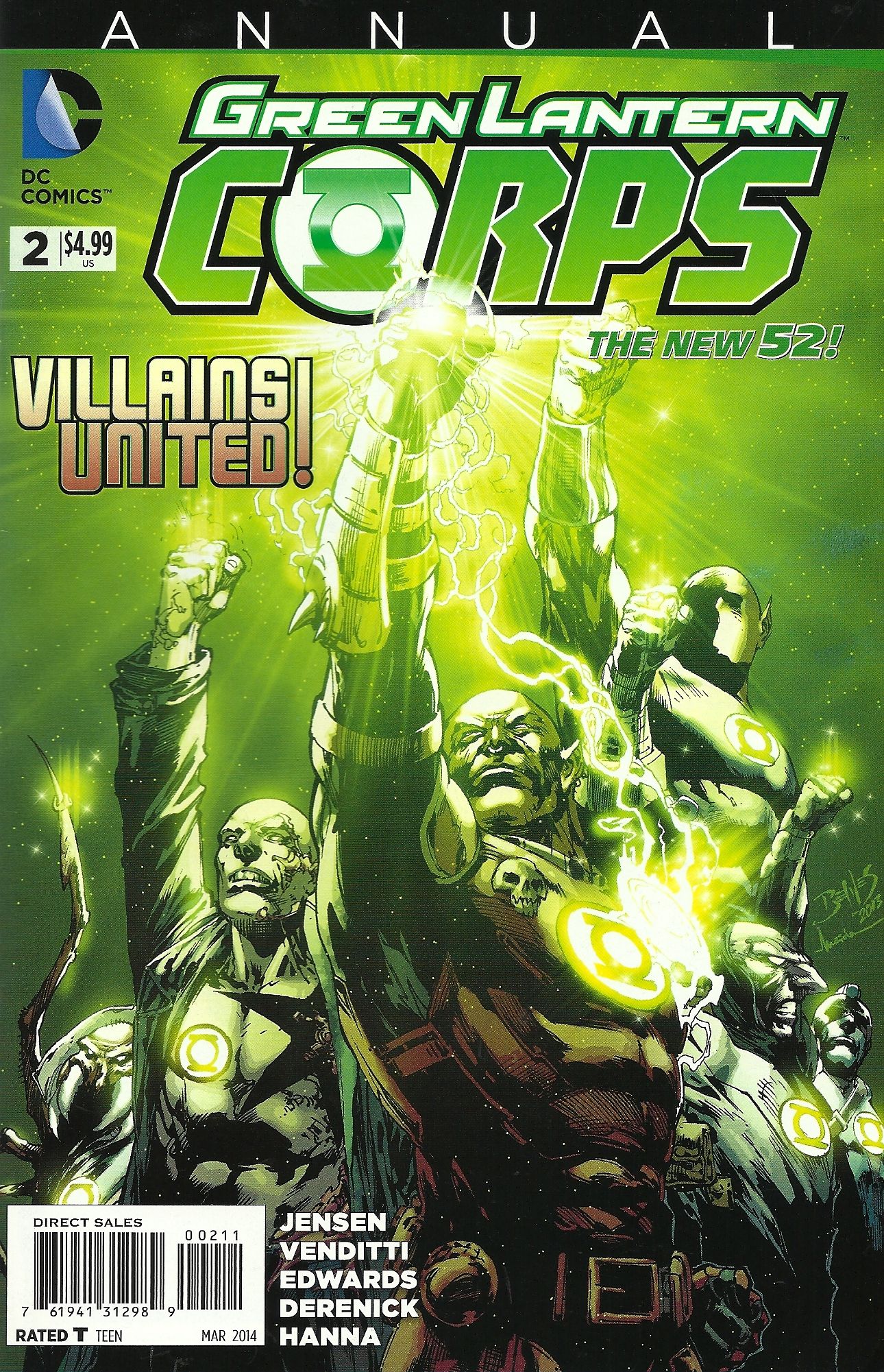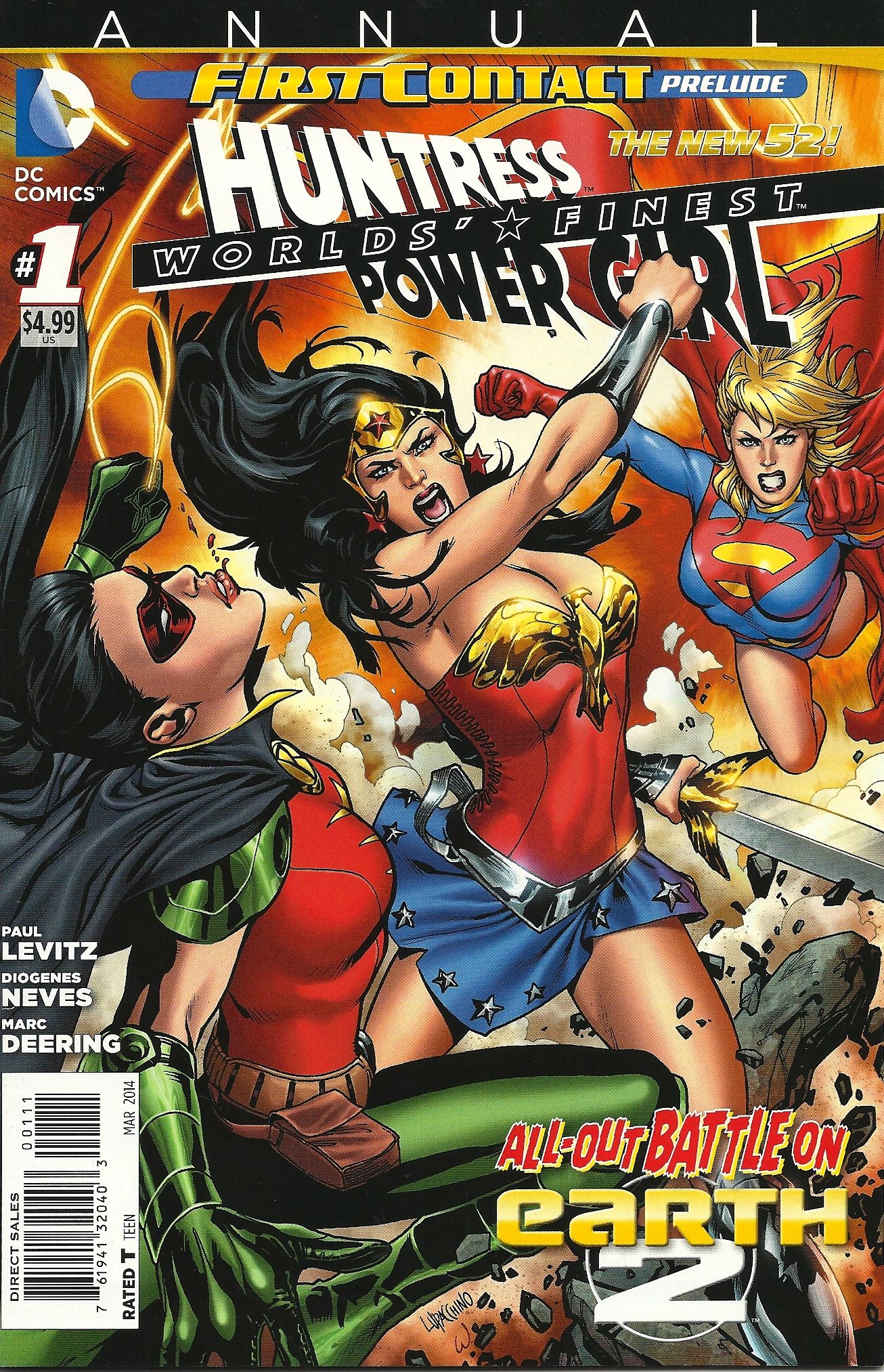This week DC Comics released four more annuals, three of which are set in the past and one of which is a big, bridging chapter in an ongoing plot line. All are penned by the regular writers of their series, and are $4.99 for 38 pages. What else do you need to know?
Oh, who made them, what they're about and whether they're any good? Oh, sure, I can tell you that ...
Batman and Robin Annual #2: Mike McKone eases back into the DC Universe with this cover, featuring his distinct, hooked-beak version of Batman, before he becomes the artist of the upcoming Justice League United. For the purposes of the annual, at least, the Peter Tomasi-written title formerly known as Batman and Robin — but currently going by Batman and (Fill in the Name of the Guest Star) — gets its original title back, for a team-up tale featuring Batman and Robin. Or Robins, actually.
Set after the death of Damian Wayne, it's a story within a story within a story, as Nightwing Dick Grayson relates to the mourning Bruce Wayne and Alfred the time he told Damian about his first week as Robin. Between Nightwing #0 and the upcoming Secret Origins #1, Grayson's new origin and presumably short time as Robin seem to be getting a lot of attention.
The story focuses on Batman's reluctance to take on a teenage sidekick and the tension it causes with the determined-to-be-a-vigilante Grayson. Here the latter faces his first superhuman villain, a new-ish character named Tusk (who looks like an anthropomorphic elephant man, sans trunk and ears).
Tomasi's plotting is pretty tight, and he pulls off a neat trick of making the story about the relationships between various Batmen and Robins within a relatively short page count. He writes all of these guys really well, although the script was surprisingly vague about Grayson's use of lethal tactics against Tusk (he survives, but Grayson kicks him out of a helicopter right in front of Batman) and whether Damian later killed Tusk. Given that whether to kill villains was such a point of conflict in Tomasi's run, it seemed odd to leave these points vague.
The art is by Doug Mahnke and regular Batman and Robin penciler Pat Gleason, two of DC's better artists whose work is also stylistically close enough that they can seamlessly share a book like this, and the same gang of inkers usually associated with Mahnke: Christian Alamy, Keith Champagne, Tom Nguyen, Mark Irwin, Mick Gray and Mahnke himself. Obviously, that's a lot of cooks in the kitchen, but they've worked together a lot during Mahnke's run on Green Lantern, and this is easily the best-looking of the four annuals.
Earth 2 Annual #2: So, have you been dying to find out who the new Batman of Earth 2 is, the mysterious, red-and-black-garbed, apparently super-powered Batman who showed up at the beginning of writer Tom Taylor's run? Well, buy this book and wonder no longer!
I won't spoil it here, but I will note that this Batman's surprising secret identity — shocking even, according to the cover text — is actually a surprising secret identity of another alternate-reality version of Batman from another comic set in a different timeline than that of the "real" DC Universe, although it's handled quite differently here (so no points for creativity, Taylor, but nice execution nonetheless). However, I will spoil the source of this Batman's super-strength: an addictive super-drug with the familiar name of Miralco.
"The effects last about an hour," Batman explains. "I stole it from an old colleague. A man named Rex Mason." So not only is this guy Earth 2's Batman II, he's also kinda-sorta its Hourman!
Taylor's entire annual is devoted to telling the new Batman's origin story, and it's presented as just that: the new Batman telling his origin story to Red Tornado and Hawkgirl, as the last four pages of the story reveal. The preceding pages tell the story of Earth 2's original Batman, from the death of his parents to his own sacrifice in Earth 2 #1, from the prospective of the new character, so we also get quite a bit of information about the original Earth 2 Batman's origin, and learn more about the Earth 2 equivalents of characters like Jarvis Pennyworth, Joe Chill, the Falcones and the Waynes.
Penciler Robson Rocha's art isn't terribly remarkable -- he does much better with Batman and the super-people at the end than he does with the many plainclothes civilians that fill the issue — but it's not bad work, either. Just unremarkable, which, in today's crowded market, is unfortunately not too different from bad work.
Green Lantern Corps Annual #2: But on the subject of bad work, cover artists Ed Benes and Marcelo Maiolo's piece is meant to be a reference to a Green Lantern: Rebirth cover by Ethan Van Sciver, but the figures are so sketchily rendered and the green coloring so over-powering that the impact of the image is lost. Those are some pretty well-known Green Lantern and space villains apparently joining the Corps, but good luck noticing Kanjar Ro, the Faceless Hunter, Bolphunga* and Evil Star (the latter of whom has a new, less-ridiculous -- but consequently less-distinct -- design).
It's kind of a shame that the attempt at an allusion trips the artists up, because otherwise the cover would function just as it should, showing readers something strange and unbelievable, a surprising turn of events that the story underneath it gradually works its way up to. Co-writers Van Jensen and Robert Venditti bring to boil a long-simmering plot line in which the Durlans, alien shape-shifters of the DCU, and their evil allies have begun tearing apart the still-reeling Green Lantern Corps. Realizing they ultimately share a worse enemy, the Corps forges an alliance with a bunch of its former enemies, many of whom appear on the cover and get little one-page origin stories throughout the annual.
Creative team hiccups aside, DC seems to have done remarkably well at keeping the tone and style of the storytelling established by Geoff Johns, Peter Tomasi and the other writers. Big, sweeping action stories that bounce from existential crisis to existential crisis, the state of the Green Lantern Corps and the universe it patrol always in flux. I imagine they lost a lot of readers when Johns and company left, but I imagine a lot of those fans who took Johns' departure as a jumping-off point would be surprised to find how little the books have really changed.
The art duties are rather cleverly split, with Neil Edwards handling the majority of the artwork, while Tom Derenick draws the origin-story flashbacks featuring the villains (Evil Star, Bolphunga, the Faceless Hunter Chun Yull, Kanjar Ro and "Hunger Dog"). Their styles are pretty similar, although I prefer Derenick's work to Edwards', as the latter has a tendency to bizarrely over-"act" in certain panels, and many of his pages lack much in the way of detail to ground all the crazy aliens and outer space business in something more tactile.
Worlds' Finest Annual #1: The fine print assures me that's the title of this comic book, although looking at the mess of words and logos across the top of the cover, it looks like the book could very well be called Annual: First Contact Prelude: Huntress The New 52!: Worlds' Finest Power Girl.
Like Earth 2, this annual, by writer Paul Levitz, penciler Diogenes Neves and inker Marc Deering, dips back into the history of the New 52 alternate Earth, where The Huntress used to be the daughter of Batman and Catwoman and also used to be Robin, and Power Girl used to be Supergirl, before they came to Earth-New 52. After a splash page and paragraph of text reminding us of that, the annual flashes back to before Apokolips' invasion, when things were more or less happy for our heroines and their home world.
The issue is broken into three interconnected vignettes: The first finds Batman and Robin trying to uncover a brothel; the second involves Supergirl using a fake ID to sneak into a bar and meeting an older man with a ponytail, who then gets killed in a terrorist attack; and then, finally, Robin and Supergirl unite to track down the party responsible for the bombing, and find Fury, the daughter of Wonder Woman ... as well as Wonder Woman herself.
Levitz's scripting is so old-school that it's at once refreshing and amusing (like the way he still writes thought bubbles for the characters, but they're lettered as narration boxes instead), and I'll be damned if he didn't even make me laugh once ("No shock, Sherlock" ... that's the Earth 2 version of a familiar saying, I guess). The story doesn't really have a conclusion, but then, we knew that going in: Note the word "prelude" among the jumble of verbiage atop the cover. This apparently leads into the Batman/Superman and Worlds' Finest crossover, in which the young ladies meet the Earth-New 52 versions of their deceased fathers.
Neves does a nice job in making the somewhat-goofy costumes of some of the characters — particularly Robin's over-armored get-up, and Superman's strange girdle design — work, and his art is clean and crisp, finding a nice balance between expressive action comic and grounded storytelling. It sure helps that colorist Jason Wright does such a fine job on the book, distinguishing the chapters in the predictable but effective way: Batman and Robin's Gotham adventures are darker than Supergirl's New York adventures, even though both take place at night.
*Much has been made by many comic book fans of a recent interview Alan Moore gave. The man certainly has a right to be fed up with, and irritated, by modern super-comics, many of which would likely fail to impress him if he read them. This 38-page annual, for example, features two characters he and Dave Gibbons created almost 30 years ago for a short, one-off, twist story.

